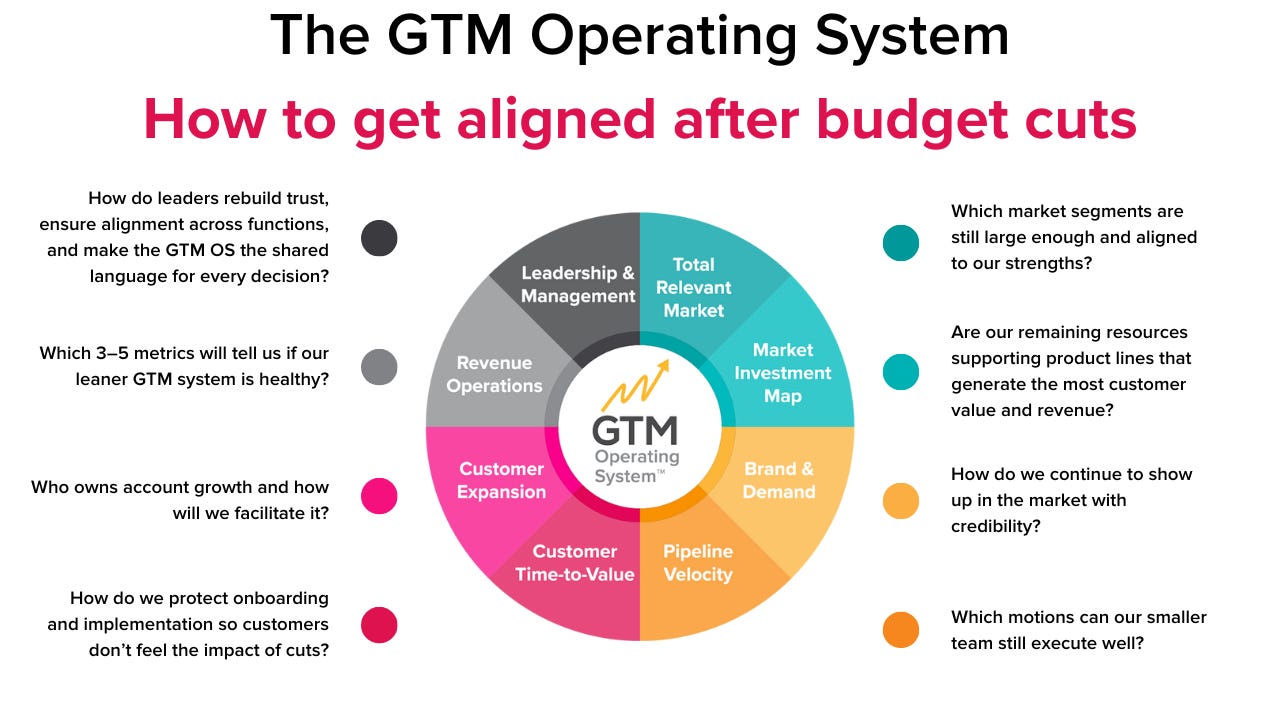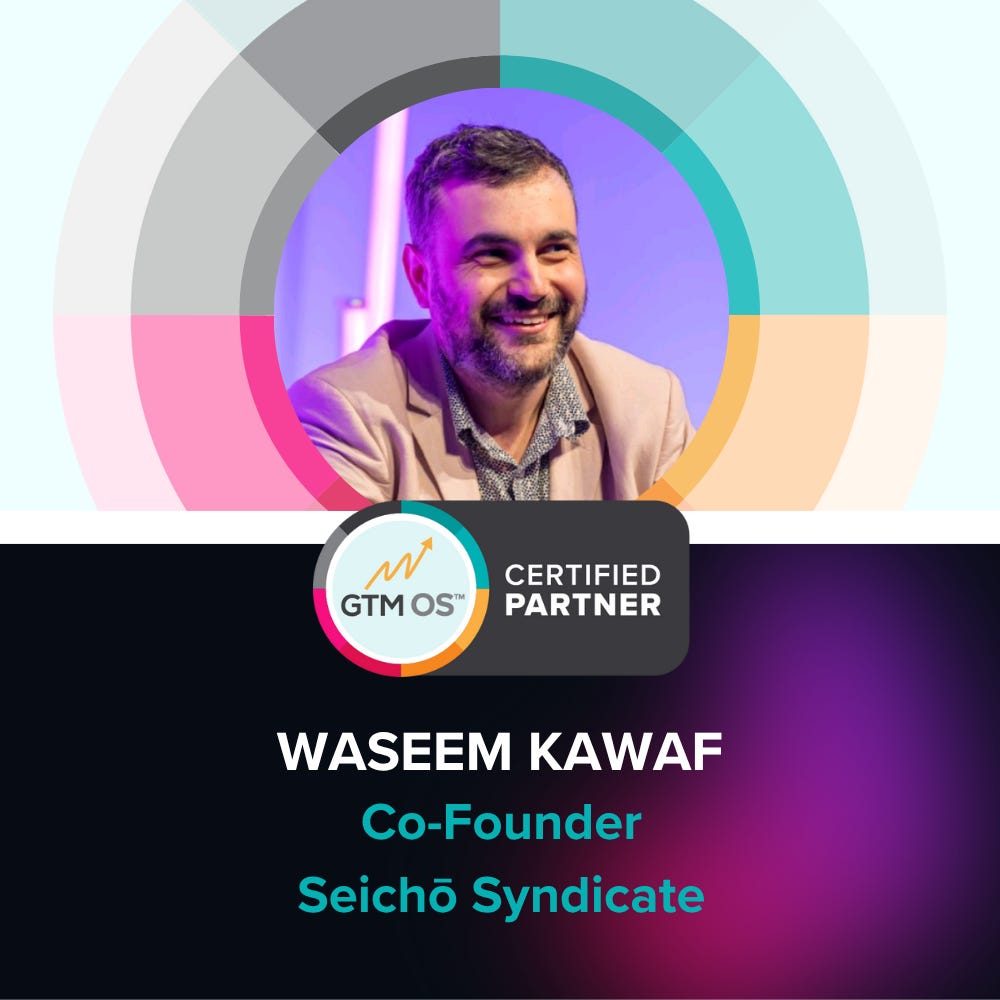How to Use the GTM Operating System to Recalibrate After Budget Cuts or a RIF
The 8-pillar framework to regain alignment, protect customers, and rebuild trust when resources are lean.
Thanks for being one of over 175,000 forward-thinking GTM Leaders who subscribe to this weekly research note.
This week’s research note includes:
GTM Research: How to Use the GTM Operating System to Recalibrate After Budget Cuts or a RIF
GTM OS Certified Partner Spotlight: Waseem Kawaf
Upcoming Events and Access
Research: How to Use the GTM Operating System to Recalibrate After Budget Cuts
Every week, we’re talking with companies that are trying to operate on leaner budgets—or navigating a reduction in force (RIF). The stories are familiar:
Leadership teams under pressure to cut spend fast.
Vendors promising that AI will replace headcount and make everything more efficient.
Teams scrambling to do more with less.
Here’s the hard truth: tools and tactics can’t fix a lack of strategy. If your company isn’t aligned on the fundamentals, no amount of AI or efficiency plays will solve the problem.
And while it may be tempting to skimp on strategy when budgets are tight, now is precisely when you need it most. Without a clear operating system, you risk cutting the wrong things, confusing your team, and losing market momentum.
The Reality of RIFs
The pressure to cut costs is real. Salesforce alone has made headlines in 2025, eliminating over 8,000 roles across multiple rounds of layoffs—even while posting strong earnings and doubling down on AI. They aren’t alone.
Across industries, the story repeats: headcount reductions and budget cuts in the name of efficiency. But cutting jobs doesn’t automatically stop the bleeding. In fact, it often leaves teams less focused, more fractured, and unable to execute against growth targets.
So how do you stop the cycle?
Aberdeen reports that when GTM is aligned, companies see 24% faster growth and 27% higher profit growth over a year. Other studies back this up: aligned organizations grow faster, are more profitable, and close deals more effectively.
The real question is not what AI tool should I buy? The question is: how do I connect strategy with execution in a leaner environment?
Our answer: run your business on the GTM Operating System…like hundreds of companies already do.
Budget cuts change everything: capacity, priorities, and confidence. Customers wonder if you can still deliver. Employees question whether they’re safe. Leaders struggle to balance optimism with transparency.
The GTM OS forces the right questions—so you cut wisely, protect what matters, and align your remaining resources to the highest-impact work.
The Eight Pillars of GTM OS: Navigating Budget Cuts
1. Total Relevant Market — Where can you grow the most?
Strategic questions: Which market segments are truly viable with reduced capacity? What customers deliver the highest ROI? Which segments should we walk away from?
Where AI can help: Use AI-driven data analysis to identify patterns in customer profitability, churn, and lifetime value.
Leadership focus: Make tough calls on narrowing scope. Overcommunicate why certain markets are prioritized and why others are not.
2. Market Investment Map — Which product(s) create the highest customer value?
Strategic questions: Which products must we protect because they drive the most customer impact? Which bets can be paused or killed?
Where AI can help: AI tools can analyze product usage and adoption data to highlight which offerings deliver the most measurable customer value.
Leadership focus: Clarify product priorities for the entire org so no team wastes time building, selling, or marketing features that don’t matter.
3. Brand & Demand — How will you engage your customer with a differentiated POV?
Strategic questions: Which campaigns, channels, and messages still cut through? Where do we repurpose content instead of creating net-new?
Where AI can help: AI can speed content repurposing, create drafts for leaner teams, and optimize campaigns. But it can’t define your POV.
Leadership focus: Reinforce confidence in the market by showing up consistently—even when spend is down. Invisibility is riskier than lower spend.
4. Pipeline Velocity — Which GTM motions get you to your revenue goal faster?
Strategic questions: Which motions (inbound, outbound, event-led, partner-led) are still executable with fewer people? Which should we pause?
Where AI can help: AI can automate prospect research, prioritize leads, and streamline outreach to accelerate existing motions.
Leadership focus: Cut the motions you can’t execute well. A few motions done with excellence are better than many done poorly.
5. Customer Time-to-Value — How do customers experience your ROI?
Strategic questions: How do we ensure customers see results quickly even with smaller teams? Are onboarding processes efficient enough to withstand cuts?
Where AI can help: AI can support customer onboarding with chatbots, knowledge bases, or proactive nudges.
Leadership focus: Protect implementation and onboarding capacity. Nothing kills confidence faster than customers feeling your cuts.
6. Customer Expansion — How else can you upserve your customers?
Strategic questions: How do we maintain upsell and cross-sell opportunities with fewer people? Who owns expansion?
Where AI can help: AI can flag accounts with expansion potential based on usage, engagement, and intent data.
Leadership focus: Ensure clear ownership of expansion plays. Without defined accountability, expansion opportunities will vanish.
7. Revenue Operations — Which GTM metrics drive your business health?
Strategic questions: What 3–5 KPIs matter most in this new reality? How do we measure efficiency, not just activity?
Where AI can help: AI can surface anomalies, predict pipeline health, and provide leading indicators of churn.
Leadership focus: Reset dashboards and make them visible across the org. In times of cuts, transparency builds confidence.
8. Leadership & Management — How do you give your team clarity, alignment, and trust?
Strategic questions: How do we make sure every person knows the company’s priorities and their role in achieving them?
Where AI can help: AI won’t replace leadership, but it can streamline internal communication, sentiment analysis, and knowledge sharing.
Leadership focus: Over-communicate. Lead with clarity and empathy. Rebuild trust by making the GTM OS the common language for every decision.
The Big Takeaway
When budgets get cut, the temptation is to chase efficiency hacks and shiny tools. But efficiency without strategy just accelerates misalignment.
Now is not the time to skimp on strategy. In fact, the leaner your budget, the more you need a clear operating system to guide every decision. The GTM OS keeps leaders focused on the fundamentals: the right markets, the right products, the right motions, and the right metrics.
That’s what makes AI tools and tactical efficiencies actually work—because they’re anchored in strategy, not wishful thinking.
And if you want your entire team aligned and rowing in the same direction, GTM University is designed to do exactly that. It’s where teams learn to apply the GTM OS together, building shared frameworks and shared language for the toughest—and most important—decisions.
Certified Partner Spotlight: Waseem Kawaf with Seichō Syndicate
Unifying Brand, Product & Revenue for Scalable Growth
Growth isn’t a department—it’s a discipline. That’s the philosophy behind Waseem Kawaf’s work at Seichō Syndicate, a modern GTM advisory helping ambitious companies align brand, product, marketing, and sales into one high-performance growth engine.
Waseem brings a unique mix of AI-powered GTM strategy, human-centered UX, and predictive design to help teams move faster, make smarter decisions, and deliver real-world impact. Whether you’re rethinking your go-to-market, building sales enablement systems, or transforming RevOps, Seichō Syndicate delivers the strategy and execution to unlock sustainable, scalable performance.
Core Areas of Focus:
Go-to-Market Strategy
Revenue Operations (RevOps)
Sales Enablement & Training
Organizational Transformation
Brand & Product Integration
Why It Works:
Waseem helps companies move with clarity and speed—aligning cross-functional teams around shared outcomes, modernizing infrastructure, and creating systems that scale.
Looking to break silos and drive next-level growth?
Learn more: Waseem Kawaf Partner Page →
If you’d like to be a certified GTM Partner like Waseem and more than 40 others, we’d love to talk to you about how to make that happen.
Upcoming Events: Where Sangram, Bryan, or a GTM Certified Partner Will Be Speaking
(DM Sangram for a discount code to attend or to get slides after the talk)
Why Most Startups Don’t Scale: The 15 GTM Mistakes Nobody Talks About (Hosted by GTM Certified Partners Tim Hillison of Entry Point 1, Lydia Flocchini of Motion to Scale, and SF Tech Week). This event is part of SF Tech, Oct 8, San Francisco
Show Me the Money: AI’s Impact on GTM (hosted by GTM Certified Partners Murtaza Kumail Abbas and Avnita Gulati), October 8 at 11 a.m. on LinkedIn Live
Fix Your Revenue Leaks - A GTM Workshop (hosted by GTM Certified Partner Sandy Yu) is running 7 city roadshow on 15 GTM problems in a city near you and there are 5 more to go: Amsterdam (Oct. 9), Copenhagen (Oct. 16), Singapore (Nov. 4), New York City(Nov. 13), Melbourne (Dec. 3)
The Work Pause: a One-Hour Workday Retreat for GTM Leaders (hosted by GTM OS Certified Partner Sarah Allen-Short), October 22 from 12-1 p.m. EST on Zoom.
Why Most Startups Don’t Scale: The 15 GTM Mistakes Nobody Talks About (Hosted by GTM Certified Partners Tim Hillison of Entry Point 1, Lydia Flocchini of Motion to Scale, and Tech Crunch). This event is part of Tech Crunch Disrupt 2025, Oct 28, San Francisco
Usage Economy Summit (hosted by LogiSense) Nov 5, San Francisco
Love,
Sangram and Bryan
p.s. Access GTM University | Hire GTM OS Certified Partners | Read Fractional Friday
Thanks for reading GTMonday by GTM Partners!
Subscribe for free to receive new posts and support our research work.



